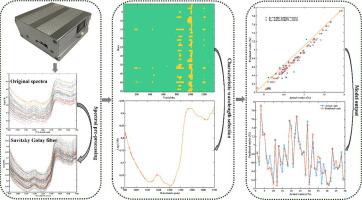Spectrochimica Acta Part A: Molecular and Biomolecular Spectroscopy ( IF 4.3 ) Pub Date : 2023-12-07 , DOI: 10.1016/j.saa.2023.123740 Guangxin Ren 1 , Lingling Yin 2 , Rui Wu 2 , Jingming Ning 3

|
Ash is a testing index with both health inspection value and quality decision value, and it is an essential detection item in the import and export trade of tea. To realize the rapid and effective quantitative analysis of ash content in tea, this study proposed the use of a homemade miniature near-infrared (NIR) spectroscopy combined with multivariate analysis for the rapid detection of ash content in black tea. First, NIR data of black tea samples from different countries were acquired and optimized by the spectral preprocessing method. Then, the optimized pre-processed spectral data were used as features, and four feature wavelength selection algorithms, such as competitive adaptive reweighted sampling, iteratively retaining informative variables (IRIV), variable combination population analysis (VCPA)-IRIV, and interval variable iterative space shrinkage approach (IVISSA), were utilized to optimize the feature spectra. Finally, the support vector machine regression (SVR) algorithm was employed to construct the quantitative models of ash content in black tea by combining the optimal wavelengths obtained from the four feature selection methods mentioned above. The experimental results showed that the IVISSA-SVR model had the best performance, with correlation coefficient (Rp), root mean square errors of prediction (RMSEP), and relative prediction deviation (RPD) of 0.9546, 0.0192, and 5.59 for the prediction set, respectively. The results demonstrate that a miniature NIR sensing system combined with chemometrics as an effective analytical tool can realize the rapid detection of ash content in black tea.
中文翻译:

自制微型近红外光谱仪快速检测红茶中的灰分含量
灰分是一项兼具卫生检验价值和质量判定价值的检测指标,是茶叶进出口贸易中必不可少的检测项目。为了实现茶叶中灰分含量的快速、有效定量分析,本研究提出利用自制微型近红外(NIR)光谱仪结合多元分析技术对红茶中灰分含量进行快速检测。首先,通过光谱预处理方法获取和优化来自不同国家的红茶样品的近红外数据。然后,以优化后的预处理光谱数据为特征,采用竞争自适应重加权采样、迭代保留信息变量(IRIV)、变量组合总体分析(VCPA)-IRIV、区间变量迭代等四种特征波长选择算法利用空间收缩方法(IVISSA)来优化特征谱。最后,结合上述四种特征选择方法得到的最佳波长,采用支持向量机回归(SVR)算法构建了红茶灰分含量的定量模型。实验结果表明,IVISA-SVR模型的性能最好,预测的相关系数(R p )、预测均方根误差(RMSEP)和相对预测偏差(RPD)分别为0.9546、0.0192和5.59分别设置。结果表明,微型近红外传感系统结合化学计量学作为有效的分析工具,可以实现红茶中灰分含量的快速检测。


















































 京公网安备 11010802027423号
京公网安备 11010802027423号